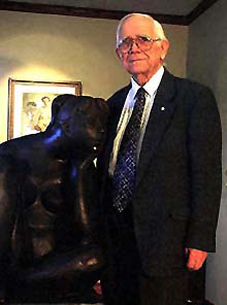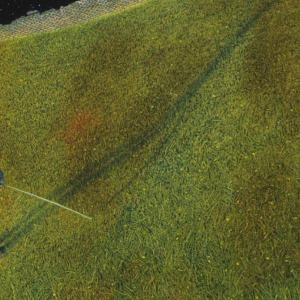"Citizen Mol: A century after his birth, world-renowned artist's work accessible across Winnipeg"
By Kevin Prokosh
Winnipeg Free Press
January 17, 2015
Like no other Winnipeg painter or sculptor, Leo Mol made this city his personal art gallery.
His public works, gathered most prominently at Assiniboine Park's Leo Mol Sculpture Garden, are embedded in the fabric of his adopted hometown in a way no other artists' works are. It's difficult to drive anywhere inside the Perimeter without passing his monuments, signature bronze sculptures, glorious stained glass windows or murals.
From the 1950s to his death in 2009, Mol was the one charged with immortalizing our God, heroes, leaders and wildlife. Wherever Winnipeggers gather, a Mol creation is nearby.
The sculpture at Portage and Main (Tree Children) depicting kids frolicking on branches is his, as is the iconic Tom Lamb sculpture standing nearby in the lobby of the Richardson Building. Up Main Street, at Mountain Avenue, his impressive exterior mosaic overlooks the entrance to Holy Trinity Ukrainian Orthodox Cathedral.
His Taras Shevchenko* monument in front of the Manitoba Legislative Building is not far from his statue of Queen Elizabeth II or the life-size bronze he created of spymaster Sir William Stephenson in Memorial Park. His divine stained glass windows glow in about 15 churches, as well as at Daniel McIntyre Collegiate Institute.
"It was a big point of pride to see his art all over the city," says art dealer Bill Mayberry. "Every artist wants their world to be seen. Placing a piece in a prominent place is for eternity. That is the ultimate compliment."
Like the unpretentious man, Mol's work is realistic, honest and accessible to all. The attainment of riches or renown were never the inspiration for Leonid Molodozhanyn, born 100 years ago on Jan. 15, 1915 in the Ukrainian village of Polonne.
"A blue-collar artist for a blue-collar town is a very good description of Leo," says Rev. Msgr. Michael Buyachok of the Cathedral of Saints Vladimir and Olga, which boasts 16 stained glass windows by Mol.
The son of a potter came to Canada in 1949, settling in Saskatchewan to work as a farmhand before boredom drove him to seek the bright lights of the big city of Winnipeg. Right from the start, Mol made his living off of his artistic talents by decorating churches with his paintings. He proved himself a master portrait sculptor who was sought after to commemorate popes, presidents and VIPs.
Mol's international breakthrough came in 1962 when he was the surprise winner of a global competition to design a monument to Ukrainian poet-hero Shevchenko that stands in Embassy Row in Washington D.C. His bust of American president Dwight Eisenhower sits not far away in the capitol's National Portrait Gallery. He was also chosen to create a full-size rendering of prime minister John Diefenbaker, which stares out over Parliament Hill. His busts of Pope Paul VI, Pope John XXIII and Pope John Paul II are all in the Vatican.
The unassuming artist was proudly old school and resisted the art world's movement of the moment. His work was directed for the grasp of the common folk and not at any art-buying elites. He felt snubbed by the Canadian art community but Winnipeggers chose him one of the Greatest Manitobans.
"He was a world-class sculptor," says Hartley Richardson, a friend and patron. "He is still perhaps better known outside Winnipeg."
Since he wasn't given to self-promotion, Mol never got his due, says David Loch, the Winnipeg art gallery owner who represented Mol.
"We take him for granted," says Loch. "He should be sitting on a pedestal, but Leo never wanted to be on a pedestal. He was never given the credit he should have been given. He was Canada's No.1 portrait sculptor, without a doubt."
Mol was content to make himself work rather than rich. He lived with his wife Margareth in the same modest home on Claremont Street in Norwood Flats for all of his life in Winnipeg. Loch could drive a Mercedes but Mol was content with his economy car. His frugality didn't allow for much personal fanfare.
"He never thought of himself as anything special even though he was extremely special," says Loch. "He was born to be an artist. He couldn't have been anything else."
Mol always plowed his commission money back into his work, including making a copy of every creation. In 1990 he donated his entire collection of bronzes and ceramics, valued at $4 million, to the city which was turned down initially. Richardson, Loch and others led the campaign that culminated in the opening of the Mol sculpture garden in 2003.**
Over a decade it has become a top tourist destination and a place Winnipeggers proudly show off to their out-of-town guests. Even on the coldest days, with the pavilion closed and the paths icy, you can find visitors admiring the sculptures. Mol appears to be a man for all seasons for all time in this city.
"He will be remembered for those pieces," says Mayberry. "The sculpture garden is not going away any time soon. There are also thousands of pieces in private hands that will be passed down to the next generation. Along with every piece goes Leo Mol's name.
Many expect his Tom Lamb sculpture—in which the parka-wrapped aviator reaches to spin a propeller—will be his legacy. Richardson gave his father George a larger version for his 60th birthday.
"That single piece is enough to carry him through another hundred years. I think it has become his one great piece of Canadiana."
* The monument of Taras Shevchenko located on the Manitoba Legislative Grounds was incorrectly attributed to Leo Mol. It was designed and sculpted by Andrew Daragan with assistance by Roman Kowal.
** The Leo Mol Sculpture Garden was officially opened in June 18, 1992.



